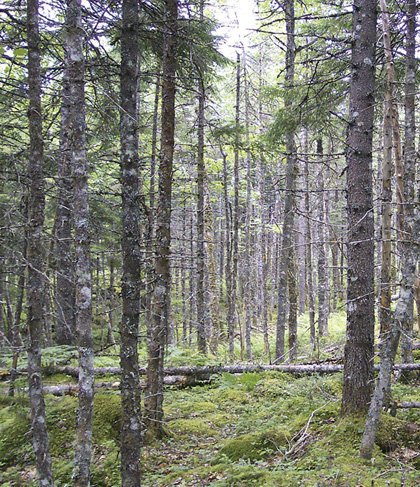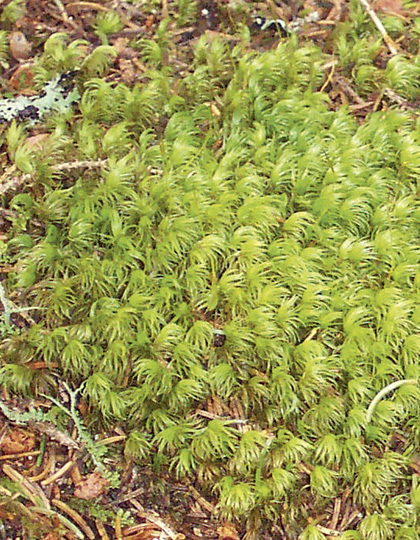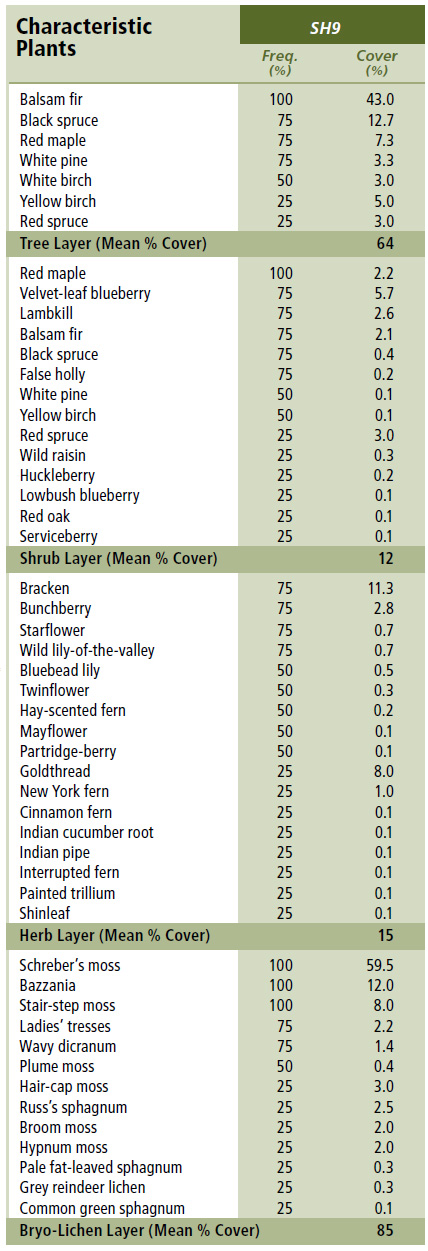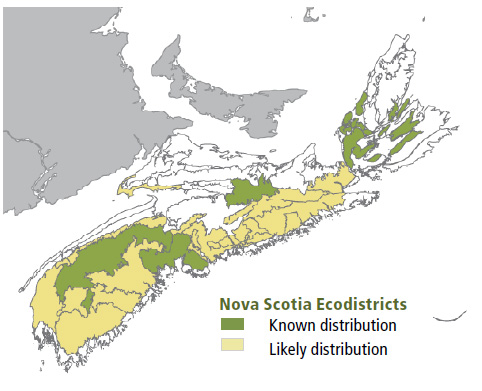
Forest Vegetation types - SH9
SH9 — Balsam fir – Black spruce / Blueberry
Abies balsamea – Picea mariana / Vaccinium spp.
 |
Mount Uniacke, Hwy 101, Hants County |
Concept: This early to mid-successional Vegetation Type (VT) has abundant balsam fir with minor coverage of black spruce, red maple and white pine. Due to the short-lived nature of balsam fir, this VT is often associated with significant coarse woody debris (CWD) and/or snags, as well as extensive balsam fir regeneration. Balsam fir – Black spruce / Blueberry usually follows stand-replacing disturbance events such as insect infestation, windthrow or harvesting.
Vegetation: Balsam fir is the dominant overstory tree along with varying amounts of black spruce, hybrid (red/black) spruce, red maple and white pine. White pine residuals can also be found in a super canopy. Understory layers have low species diversity, with the shrub layer providing the greatest coverage (mostly regenerating balsam fir, red maple and black spruce along with velvet-leaf blueberry and lambkill). Bracken and bunchberry are the most abundant herbs with Schreber's moss and stair-step moss the dominant bryophytes. Coverage of bazzania is influenced by the amount of CWD.
Environmental Setting: SH9 is mainly associated with dry to fresh, nutrient poor soils of glacial origin. These soils are generally medium to coarse textured and often very stony. This VT is found throughout Nova Scotia, but is most common in the western ecoregion.
Successional Dynamics: SH9 is a predominantly even-aged, early to mid-successional VT dominated by balsam fir. This VT usually follows stand-replacing disturbances such as insect infestation, windthrow or harvesting. In the absence of disturbances that promote balsam fir cover, SH9 can succeed to SP4 (White pine / Blueberry / Bracken) and SP5 (Black spruce /Lambkill / Bracken) on poorer sites and to SH4 (Red spruce – White pine / Lambkill / Bracken) on more zonal sites.
Ecological Features: This closed canopy forest occurs as small to large patches within broader spruce-fir matrix forests. The short life-span of balsam fir contributes substantial coarse woody material to the ecosystem, often occurring in pulses following insect outbreaks, disease or destructive wind storms. Balsam fir is very shade-tolerant, regenerating well in the understory. On moist sites black spruce typically regenerates by layering, forming small clonal groups. Mature forests may provide habitat for red and flying squirrels, deer, moose, salamanders, songbirds and small mammals, among other groups of wildlife. Old man's beard lichen is often abundant in old forests, providing important food and nest material. No plant or lichen species of conservation concern were found in available plot data.
 |
| Broom moss |
Distinguishing Features: This balsam fir softwood forest occurs on well drained, nutrient poor soils. Black spruce and hybridized spruce are common with white pine often in a super canopy. Bracken is the most abundant herb.
| Slope Position: | Middle5 Level3 Upper2 |
Surface Stoniness: |
(Very - Excessively)5 (Non - Slightly)3 (Moderately)2 |
Bedrock Outcrop: |
(Non-rocky)7 (Slightly - Moderately)3 |
Elevation Range: |
37 - 198m |
Slope Gradient: |
Level5 Gentle5 |
Aspect: |
West5 None2 nd3 |
Exposure: |
Moderate7 Exposed3 |
Microtopography: |
Slightly6 Level2 Moderately2 |
Drainage: |
Well4 Imperfect3 Moderately well3 |
Soil Type: |
ST154 ST23 ST33 |
Parent Material: |
Glacial till8 Till/Bedrock2 |
Rooting Depth (cm): |
(<30)3 (30-45)7 |
Duff Thickness (cm): |
(6-10)3 (11-20)7 |

